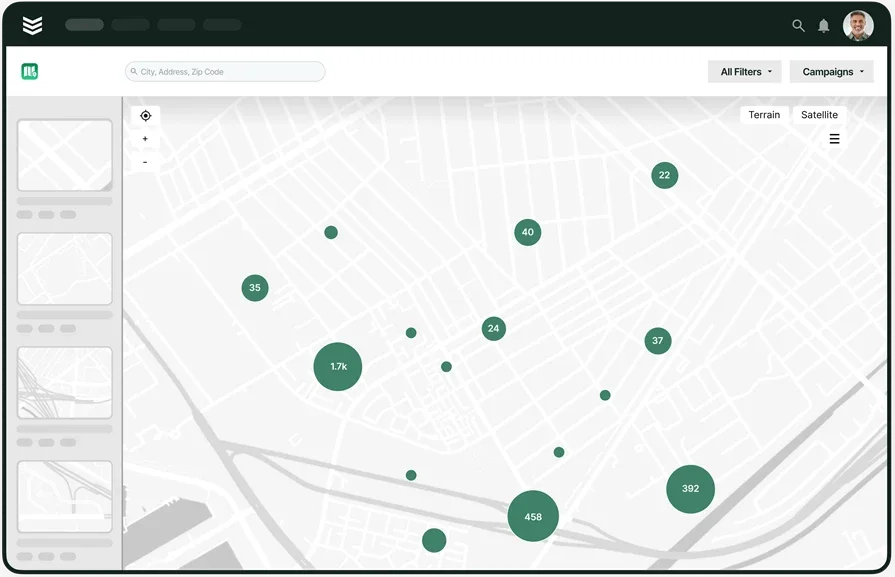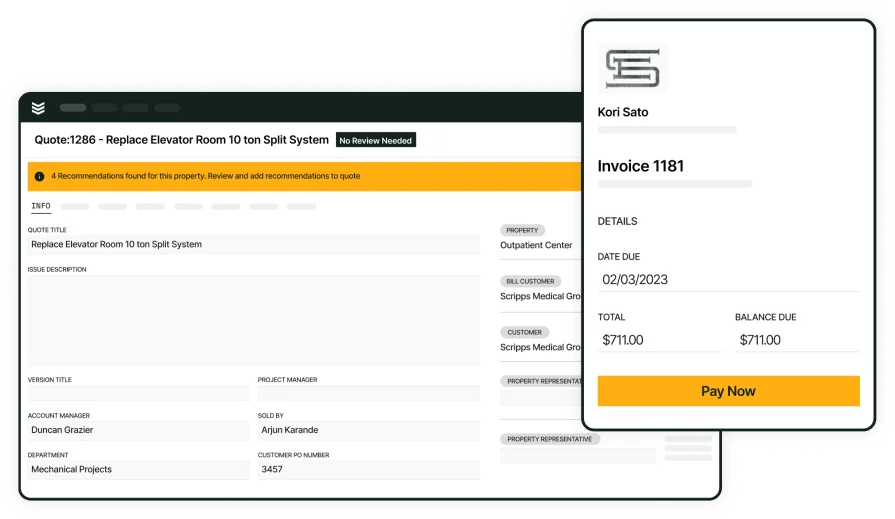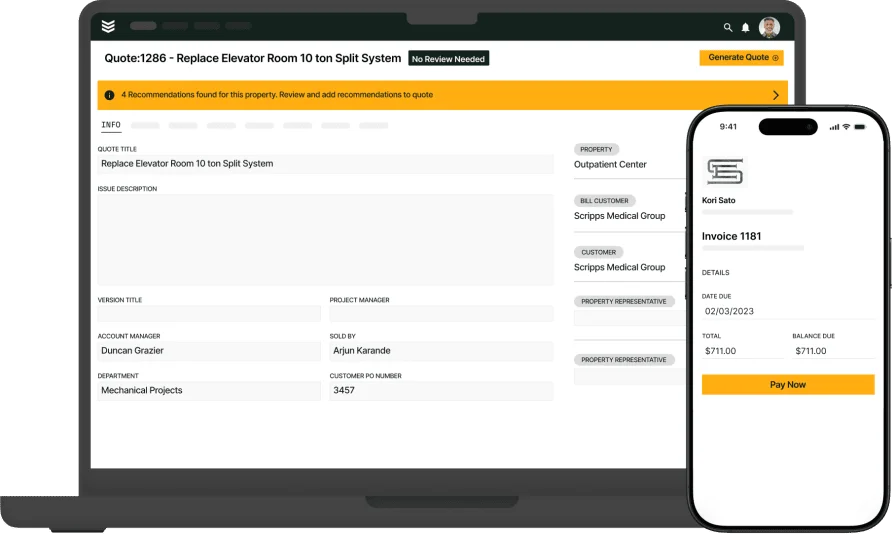If you're quoting jobs with paper forms or generic templates, you're already behind. Commercial electrical work demands more—fast quotes, detailed breakdowns, and no room for error. The old way of building proposals slows you down and opens the door for mistakes that cost you the job. That’s where electrical proposal software steps in.
From switchgear installations to multi-unit tenant build-outs, your crew needs a way to quote that keeps up with the complexity. Electrical proposal software helps you create detailed, professional proposals without burning time or missing key details. And when it plugs into the rest of your tools—like scheduling and invoicing—it keeps every part of the job connected. Contractors in the electrical industry rely on this kind of platform to stay competitive, win bigger jobs, and keep projects moving from the first quote to final payment. Here’s what this guide covers:
- Choosing the right electrical proposal software for contractors
- 6 key features that make electrical service proposal tools worth it
- 6 best electrical proposal software for all contractors
- 5 benefits of using electrical proposal software
- 4 important FAQs about electrical proposal software answered
Let’s start with what actually matters when picking a platform—how it fits your crew, your quoting process, and the pace of real electrical work.
Choosing the right electrical proposal software for contractors
The way your team builds proposals can make or break a job. Electrical work isn’t about rough estimates scribbled on paper—it’s detailed, time-sensitive, and packed with variables. From panel upgrades to full system installs, every quote needs to be fast, accurate, and easy to approve. That’s why electrical contractors put serious weight on the electrical proposal software they rely on in the field. The wrong tool slows everything down. The right one keeps your quoting sharp and your jobs on track.
Start by looking at how your team handles proposals today—who’s doing the work, what tools they’re using, and where things tend to break down. Use the checklist below to spot gaps and figure out what kind of software actually keeps up with the pace of real electrical jobs.
- Proposal ownership – Who’s building the quotes—techs on-site or someone back at the office? Do your crews need mobile access to create or adjust estimates from the field? Can your team pull in labor rates, material pricing, and project details without wasting time?
- Turnaround time – How fast can you get from site walk to customer approval? Is your current process causing delays? Does your software help speed up response times or add steps that slow everything down?
- Project type and scope – Are you quoting service calls, multi-phase upgrades, or new construction? Does your tool support detailed, line-item proposals for large-scale projects? Can it adjust for complex builds or customer-requested alternates?
- Template use and repeat jobs – Are you starting each proposal from scratch, or are you using software with built-in templates? Can your team save scopes of work, labor breakdowns, or parts lists for reuse on future bids?
- Features – Does it include branded templates, digital signature capture, and support for attachments like panel schedules or line diagrams? Can you sync pricing updates in real time? Does it connect with your CRM, job costing, or invoicing systems?
Once you’ve got a clear picture of how your current process runs, choosing the right tool becomes a lot easier. Up next, we’ll break down the key features that make electrical proposal software worth the switch.
6 key features that make electrical service proposal tools worth it
Electrical contractors aren’t just quoting wire pulls and panel upgrades—they’re quoting timelines, labor, materials, access limitations, and client demands all in one shot. Proposal accuracy can’t slip, especially when multiple jobs are running at once. The best electrical proposal software helps contractors build and send job-ready quotes while staying fully connected to scheduling, billing, and field execution. The features below make that possible—and give your team the tools to quote fast, close faster, and move seamlessly from proposal to jobsite.
1. Integrated scheduling and dispatching tools
When proposal tools connect with field service scheduling and dispatching software, your team can turn approved quotes into scheduled jobs with no delays. This keeps projects moving without duplicate data entry or missed steps.
Say your estimator finalizes a proposal for a lighting retrofit at a medical office. The moment it’s signed, the job is added to the schedule, the right crew is dispatched, and the team rolls out—no back-and-forth with the office to fill in the gaps. That’s what integrated scheduling and dispatch do for proposal-driven jobs.
2. Customer tracking and job history through CRM
Electrical proposal software becomes a lot more powerful when it syncs with a CRM built for contractors. It lets you track every client, their project history, preferences, equipment specs, and even past proposal feedback—all in one place.
For example, when a long-term commercial client calls for an upgrade to their breaker system, your team already knows the site details, access points, and previous quote history. That context lets your techs write better proposals, faster, without digging through old emails or files.
3. Field-ready proposal access with mobile tools
In the field, your crews need mobile access to build or review quotes. With a technician mobile app, estimators and techs can pull up pricing, upload photos, and generate quotes from the jobsite without returning to the office.
Take the example of a crew inspecting a failed service panel in a retail plaza. Instead of calling the office or taking handwritten notes, your lead tech uses the mobile app to build a proposal with line items, site photos, and pricing—sending it to the client before even leaving the lot.
4. Real-time job costing with time tracking
Keeping proposals accurate depends on understanding actual labor time. With time tracking software for field teams, your proposal data stays connected to the hours it takes to complete each type of work—helping you quote tighter next time.
Let’s say your crew just wrapped a conduit run through a multi-floor commercial space. You compare the estimated labor hours to the actual time tracked and realize you underbid by 8 crew-hours. That insight helps the next proposal hit closer to reality—so your profit margin stays intact.
5. Instant invoice generation from signed proposals
When proposal tools are linked to invoicing software, signed jobs flow straight into billing. No retyping. No lag time. Just clean, fast invoice creation based on the approved scope of work.
Consider a property manager who greenlights a proposal for parking lot lighting. Instead of waiting for someone to manually invoice it later, the system automatically generates the invoice with pricing, line items, and project info pulled directly from the original proposal—keeping billing tight and on time.
6. Payment capture built into the quote
Being able to accept payment right from the proposal speeds up the close. With payment tools connected to your proposal platform, you can send quotes that include digital payment options—letting clients approve and pay without extra steps.
Think about quoting a panel upgrade for a fast-food chain. Your proposal includes pricing, terms, and a payment link. The facility manager approves and pays the deposit from their phone—no printing, scanning, or delayed checks. That kind of flow helps you close jobs and collect faster.

Book more service jobs
Manage jobs from the first quote to closeout—all from a single platform.
Other valuable proposal software features for electrical contractors
While the core features of electrical proposal software handle the heavy lifting, a few extra capabilities can make day-to-day quoting even smoother. These tools won’t make or break your workflow, but they’ll tighten up how proposals connect to long-term jobs, customer retention, and team visibility. For electrical contractors quoting service calls, maintenance contracts, or multi-phase projects, these features offer added control and clarity.
- Job reporting and pipeline insights – Proposal software that includes project pipeline tracking and job reporting tools gives your team a clear view of what’s in progress, what’s been signed, and where approvals get stuck. This kind of visibility helps you prioritize follow-ups and forecast upcoming workloads.
- Service agreement integration – When proposals turn into recurring work, service agreement tools can help manage terms, renewal timelines, and scheduled visits. Perfect for electrical contractors who handle ongoing preventative maintenance or multi-year facility contracts.
- Fleet coordination features – With fleet management tools, proposal platforms can help align crew availability, vehicle locations, and equipment delivery with the jobs that just got approved—keeping field execution tightly synced to the quote.
These features might not be mission-critical, but for growing electrical teams that rely on accuracy and consistency, they can be the edge that turns good quoting into great execution.
6 best electrical proposal software for all contractors
Every electrical contractor runs a little differently. Some focus on fast-turnaround service calls. Others manage multi-phase installs or commercial projects. The best electrical proposal software depends on how your crew works, what kind of jobs you take on, and how connected your tools are in the field. Here’s a breakdown of top software options—each suited for different types of contractors—so you can figure out what matches your day-to-day best.
1. Best for commercial contractors: BuildOps
BuildOps is purpose-built for commercial electrical contractors managing large jobs, service calls, and complex installs. It helps crews build detailed, accurate proposals with tracked scopes, custom pricing, and real-time approvals. Because it integrates quoting, CRM, scheduling, invoicing, and job tracking, it keeps your whole operation connected—from the office to the field. Proposals move straight into jobs and invoices with no manual handoffs, helping you avoid missed steps and rework.
How Pricing Works: BuildOps provides tailored pricing through a live demo and custom plan walkthrough to match your team’s specific needs.
Features Beyond Proposals:
- Integrated CRM and quoting tools: Track customer history, contact info, and scope details inside every quote
- Digital signature and approval tracking: Send proposals for signature and get alerts when approved
- Connected invoicing and job creation: Turn accepted proposals into scheduled jobs and invoices instantly
What Sets It Apart for Commercial Contractors: Built for large-scale field service work with multi-crew coordination and complex quoting needs, BuildOps makes it easy to manage high-volume jobs and detailed proposals without dropping the ball.

Give BuildOps a Try
Improve day-to-day operations with an electrical proposal and bidding platform.
2. Best for field crews: Fieldwire
Image Source: Fieldwire
Fieldwire is a strong choice for electrical contractors who want blueprint markups and field task coordination tied into their quoting process. With strong mobile support, crews can update punch lists, attach photos, and note changes that impact job scope or pricing. It also supports plan viewing and version tracking, which helps keep proposals aligned with updated drawings. That said, Fieldwire lacks full-service estimating or proposal automation, making it less useful if you’re looking to streamline the entire proposal-to-invoice process.
How Pricing Works: Fieldwire offers a range of pricing tiers based on team size and feature access, with estimating tools available in higher plans.
Features Beyond Proposals:
- Drawing markup and plan access: Easily view, comment, and update proposal-related drawings
- Task management from the field: Assign and track work tied to quote scope
- Daily log and issue tracking: Document field issues that can trigger proposal revisions
What Sets It Apart for Field Crews: Fieldwire gives electrical techs and foremen better visibility into plans and work orders, especially for field-heavy projects needing fast on-site updates.
3. Best for general contractors: Procore
Image Source: Procore
Procore works well for electrical contractors who are often working as part of larger project teams and need proposal visibility across subs, GCs, and owners. It supports change order workflows, drawing updates, and RFIs—making it a solid fit when quoting on large, multi-discipline builds. Its platform is designed to keep communication flowing from estimate through project completion. However, Procore’s interface and pricing can be heavy for smaller contractors or teams that just need straightforward proposal tools.
How Pricing Works: Procore offers customized quotes based on feature sets and project needs. Larger plans come with estimating and proposal features.
Features Beyond Proposals:
- Change order management: Tie proposals to changes and revisions mid-project
- Document control and approvals: Keep proposals synced to contracts and plan sets
- Submittals and RFI tools: Clarify scope questions before they slow down the quote
What Sets It Apart for Subcontractors: Procore keeps electrical contractors in sync with the broader team on complex builds where multiple quotes, addendums, and revisions are the norm.
4. Best for takeoff-driven proposals: PlanSwift
Image Source: PlanSwift
PlanSwift gives electrical contractors a takeoff-first approach to quoting, perfect for teams that want to start proposals from plans and drawings. You can pull quantities directly from blueprints, apply pricing data, and generate estimates that feed into your proposal format. It’s especially useful for contractors working on construction builds where detailed measurements are critical for pricing labor and materials. However, PlanSwift is primarily focused on takeoffs and doesn’t offer built-in scheduling, invoicing, or CRM tools—so proposal workflows may require multiple systems.
How Pricing Works: PlanSwift offers one-time pricing per license, with add-ons available for estimating and trade-specific databases.
Features Beyond Proposals:
- Blueprint measurement tools: Drag and drop takeoffs from PDF plans
- Custom assembly libraries: Build common labor and material bundles
- Exportable pricing reports: Push estimates into spreadsheets or proposal templates
What Sets It Apart for Takeoff Pros: Ideal for electrical estimators who start every quote from a drawing and need high-precision quantity takeoffs built into their workflow.
5. Best for residential service shops: ServiceTitan
Image Source: ServiceTitan
ServiceTitan is a platform designed to help residential electrical contractors send polished proposals, track job progress, and collect payments in one place. Its proposal builder supports visual estimates, upsell options, and digital approval workflows. Everything ties back to customer history and job details, so your quotes stay connected to the full service lifecycle. That said, ServiceTitan is geared toward residential or light commercial work, and may feel too limited for electrical contractors managing large-scale builds or long-term commercial projects.
How Pricing Works: ServiceTitan uses a subscription-based model with tiered pricing based on team size and feature access.
Features Beyond Proposals:
- Visual estimate builder: Present good/better/best options for repairs or installs
- Scheduling and dispatch tools: Book jobs immediately after proposal approval
- Integrated payment collection: Take deposits or full payments right from the quote
What Sets It Apart for Residential Shops: ServiceTitan shines in busy service environments where electrical techs need to quote on-site and close the job before leaving the driveway.
6. Best for legacy workflows: Vision InfoSoft
Image Source: Vision Infosoft
Vision InfoSoft has been around for decades and remains a go-to for electrical estimators who prefer desktop-based software with customizable databases. It includes proposal generation tools tied to material pricing, labor units, and job phases. The software’s familiarity appeals to contractors who want full control over their estimate structure without switching to a cloud platform. Still, Vision InfoSoft lacks the modern integrations or mobile capabilities found in newer platforms, which can limit speed and flexibility in today’s fast-moving job sites.
How Pricing Works: Vision InfoSoft offers a mix of one-time licenses and subscription plans, depending on the version and trade modules you select.
Features Beyond Proposals:
- Custom labor unit library: Tailor each estimate based on your exact install workflow
- Electrical database pricing: Stay updated on material costs with trade-specific data
- Proposal template export: Generate client-ready documents from inside the software
What Sets It Apart for Legacy Users: It’s a solid fit for teams that prefer full desktop control over proposals and estimates, and don’t require cloud syncing or mobile tools.
5 benefits of using electrical proposal software
For electrical contractors, quoting isn’t just paperwork—it’s how jobs get won, scheduled, and paid for. The best electrical proposal software keeps your estimates accurate, connected, and fast without adding extra steps. When your quoting system syncs with your broader field operations, it does more than speed up proposals—it strengthens the entire workflow. These five benefits show what a connected quoting process can really do for your business.
1. Fewer invoice errors after the job
Proposal software that locks in labor rates, scope details, and material pricing makes invoicing much cleaner on the backend. When every quote automatically flows into the billing system, you cut down on double-entry and reduce missed charges. As noted in discussions around common billing breakdowns in the electrical contractor invoicing guide, tying your quotes to real scopes and deliverables is one of the fastest ways to fix invoice confusion before it starts.
2. Less back-and-forth between techs and office
Giving field crews the ability to build and adjust proposals themselves means fewer phone calls and delays. Rather than waiting on admin support or chasing paper notes, techs can quote jobs on the fly—right after inspecting a panel or tracing a fault. This kind of mobility aligns with how tools like electrical work order invoice systems connect job details to real-time billing and quoting from the field.
3. Better visibility into ongoing projects
When proposals feed directly into job tracking, it becomes easier to spot where time or cost drifted from the original quote. Proposal tools that connect to project schedules, crew hours, and scope changes help contractors understand where jobs succeed—and where they slip. Many teams use electrical contractor project management software to close that loop between what was promised and what actually happened.
4. Stronger relationships with repeat customers
Proposal tools with built-in customer data help your team quote with context. Knowing what gear was used last time or what service work was recently done means you can deliver faster, more accurate estimates tailored to each client. That kind of visibility, often driven by systems like the best CRM for electrical contractors, helps turn one-off jobs into long-term accounts.
5. Faster turnaround on competitive bids
Speed matters when bidding jobs—especially if your competitors are quoting from spreadsheets while you’re sending branded, digital-ready proposals. Tools that combine takeoff data, labor pricing, and templates make it easier to respond to bid requests with confidence. Contractors looking to level up often lean on tech like electrical bidding apps or AI-driven estimating platforms to tighten timelines and keep margins intact.

Improve day-to-day operations
Learn how you can manage jobs smarter from quote to closeout.
4 important FAQs about electrical proposal software answered
Electrical contractors rely on tight quotes to win business and keep jobs moving. Whether you’re building estimates from a service truck or reviewing bids in the office, the proposal tool you use has a real impact on how fast and accurate your work can be. If you’re sorting through platforms or wondering what actually matters in the field, these are the questions most electricians ask when choosing the best electrical proposal software.
1. What is electrical proposal software?
Electrical proposal software helps contractors create accurate estimates that reflect real labor, material, and scope data. It replaces handwritten quotes with digital tools that tie directly into scheduling, invoicing, and project tracking. It keeps your entire quoting process clean and connected.
For field-focused teams, this means techs can quote faster, make changes in real time, and send professional proposals from anywhere. Office teams get a clearer view of approvals, pricing consistency, and follow-ups—all from one place.
2. Can electrical proposal software handle complex commercial quotes?
Yes—but only if the platform supports detailed estimating features like custom scope lines, add-on tracking, and phased scheduling. Commercial electrical work often involves coordination with GCs, large-scale timelines, and repeat clients. You’ll want software that not only captures scope accurately, but also connects to job tracking and field service coordination. Many electrical contractors running multi-site installs or multi-system upgrades prefer tools that are flexible enough to handle all the moving parts.
3. What’s the difference between electrical proposal and bidding software?
Proposal software is designed for quoting jobs you’re already in a position to win—think recurring clients, service work, or negotiated contracts. Bidding tools, on the other hand, focus on competitive estimating where you're up against multiple firms. They’re often used on public projects, commercial build-outs, or work that goes through formal procurement. If your team handles both, choose electrical proposal software that can streamline everyday quoting while giving you options to export for competitive bids when needed.
4. What are the best practices for using electrical proposal software?
To get the most out of your proposal platform, it’s not just about the features—it’s about how you use them. The best results come from integrating quoting into your everyday operations, both in the field and at the office. Here are 10 best practices electrical contractors can follow to build faster, cleaner, and more consistent proposals:
- Set up branded templates for service calls, installs, and repair work
- Use preloaded labor and material libraries for fast scope building
- Link proposal data directly to your invoicing and scheduling systems
- Allow field techs to create or edit proposals on mobile devices
- Attach site photos, wiring diagrams, or spec sheets for context
- Require digital approvals to track proposal status and reduce delays
- Review win/loss metrics regularly to refine pricing strategy
- Sync customer history and contact info through your CRM
- Build out saved scope bundles for common job types
- Train your team to quote consistently using shared standards
The proposal is just the start—but it sets the tone for everything that follows. For electrical contractors managing tight timelines, service calls, and multi-system installs, quoting is where control begins. A strong electrical proposal software doesn’t just help you build estimates faster—it keeps your office and field crews aligned, reduces errors, and helps you win jobs with less friction.
If you're serious about scaling or simply tired of juggling tools that don't talk to each other, investing in an all-in-one field service management platform can make a big difference. Especially for commercial contractors, having proposals, scheduling, invoicing, and job tracking in one place isn’t a luxury—it’s a way to run tighter, more profitable operations.

Curious to see it in action?
See how our electrical platform handles quoting and everything beyond.







